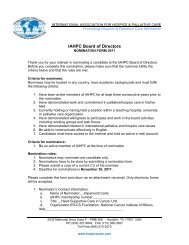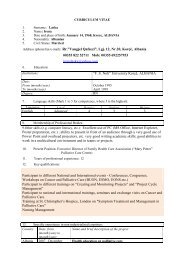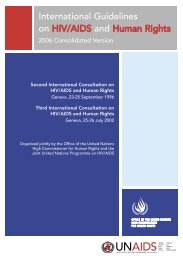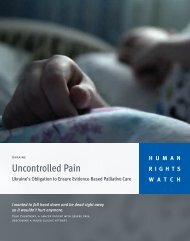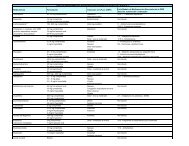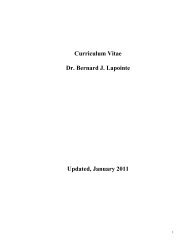INTERIGHTS Bulletin
INTERIGHTS Bulletin
INTERIGHTS Bulletin
Create successful ePaper yourself
Turn your PDF publications into a flip-book with our unique Google optimized e-Paper software.
<strong>INTERIGHTS</strong> <strong>Bulletin</strong><br />
Volume 16 Number 4 2011<br />
199<br />
the legitimate state interest of<br />
preventing the spread of MDRTB.<br />
Below we look at whether legislation<br />
and practice in Kenya has made a<br />
similar attempt.<br />
Detention of Patients with DRTB in<br />
Kenya<br />
In Kenya there are two key legislative<br />
provisions that relate to the detention<br />
or imprisonment of persons with TB:<br />
ss 27 and 28 of the Public Health Act<br />
(the Act). Under s 28 TB patients who<br />
deliberately risk the infection of other<br />
persons may be convicted of a crime. A<br />
thorough analysis of the legitimacy of<br />
this provision is beyond the scope of<br />
this article except to note that<br />
imprisonment of such persons would<br />
most likely breach WHO guidelines<br />
against detaining persons as a<br />
punishment, leaving aside that it<br />
makes no sense from a public health<br />
perspective as detention in prisons<br />
almost inevitably increases the rate of<br />
infection in prisons. 28<br />
Section 27 29 has been used by the<br />
Kenyan Government to imprison TB<br />
patients who have failed to comply<br />
with treatment regimens for whatever<br />
reason in police and prison cells. In<br />
one case three TB patients were<br />
arrested on 12 August 2010 and held in<br />
police cells. The next day one was very<br />
ill and was removed to hospital while<br />
the other two were brought before a<br />
magistrate who, on the application of<br />
the public health officer, ordered that<br />
they be confined in prison for eight<br />
months. 30<br />
The patients, with the assistance of the<br />
Kenyan NGOs KELIN, AIDS Law<br />
Project and NEPHAK, and public<br />
interest lawyers and <strong>INTERIGHTS</strong>,<br />
challenged their detention as a<br />
violation of the Kenyan Constitution’s<br />
protection of the rights to freedom of<br />
movement and personal liberty,<br />
primarily on the basis that detention in<br />
overcrowded prisons for a period of<br />
eight months was ‘excessive,<br />
unreasonable and even arbitrary.’ Even<br />
though preventing transmission of<br />
DRTB is a legitimate aim, the action<br />
taken was not proportionate to the<br />
goal. This was for a number of reasons<br />
including that the patients were<br />
detained for a long period in open<br />
prison in conditions that would<br />
exacerbate their condition and where<br />
they were likely to further spread the<br />
disease to immune-compromised<br />
prisoners. There was no information<br />
regarding the contagion level of the<br />
patients; whether they had DRTB or<br />
not, which is important because it is<br />
not necessary to detain patients who do<br />
not have DRTB; whether alternative<br />
methods of ensuring compliance had<br />
been attempted (including directly<br />
observed therapy and communitybased<br />
care and economic and social<br />
support) and what medical facilities<br />
were available in prison. 31 On 29<br />
September 2010 the High Court<br />
ordered that the patients be released<br />
and be treated at home. 32 However,<br />
the constitutional questions remain for<br />
determination, including the crucial<br />
one of whether s 27 of the Act<br />
empowers the magistrates’ court to<br />
order ‘isolation’ in a prison. 33<br />
There are a number of other<br />
arguments that could be raised with<br />
regard to s 27. While the power to<br />
isolate person with notifiable<br />
infectious diseases is an important one<br />
the section gives too much discretion<br />
to the public health officer and to the<br />
magistrates and there is insufficient<br />
guidance on when a person with an<br />
infectious disease should be isolated. It<br />
is also questionable whether the<br />
powers in s 27 are necessary and nonarbitrary,<br />
first because the power is not<br />
restricted to the most dangerous<br />
infectious diseases. All forms of TB are<br />
covered: the Public Health Act defines<br />
notifiable diseases to include ‘all forms<br />
of tuberculosis which are clinically<br />
recognizable apart from reaction to the<br />
tuberculin test.’ 34 This would mean<br />
that a patient with TB that is not drug<br />
resistant and therefore who is not a<br />
public health threat could be detained<br />
under the authority of the section. This<br />
is both unnecessary and arbitrary. In<br />
addition there already exist powers<br />
under s 26 of the Act to detain patients<br />
in hospitals and criminal sanctions<br />
(including imprisonment) under s 28<br />
for wilfully exposing the public to the<br />
chance of infection. 35 Broader powers<br />
under s 27 are therefore not necessary.<br />
While the legislation does provide that<br />
isolation can only be ordered by court,<br />
which in theory ensures due process<br />
rights, the absence of legal aid and the<br />
failure by medical staff to give clear<br />
warnings prior to the application for<br />
detention negate these procedural<br />
protections. Although the legislation<br />
provides that the detention order can<br />
be cancelled at any time by a<br />
magistrate there is no provision for<br />
automatic review of the detention or<br />
periodic testing of the detainee’s<br />
contagion levels. Again, in the absence<br />
of legal aid this power of review is<br />
made nugatory.<br />
There is no requirement in s 27,<br />
national policy or subsidiary legislation<br />
that other methods of control, such as<br />
community-based care, isolation at<br />
home or directly observed therapy, be<br />
attempted before coercive isolation.<br />
Detention under s 27 is therefore not<br />
the least intrusive limitation of the<br />
rights to liberty and freedom of<br />
movement. Many of the patients with<br />
DRTB are poor and vulnerable<br />
members of society who find it difficult<br />
to take medicine without social and<br />
economic assistance. Thus in a<br />
different case, the patient explained his<br />
failure to take the medicines for ten<br />
days on the basis that:<br />
due to hunger he would get dizzy and<br />
even at times collapse after an<br />
injection. He insisted to his family that<br />
he would only accept the medication if<br />
he is afforded at least two (2) meals a<br />
day. He used to work as a casual<br />
labourer having dropped from school<br />
in class five (5) and on account of his ill<br />
health he has been unable to engage in<br />
menial jobs. 36<br />
It is not a proportionate limitation of<br />
such a person’s right to liberty and<br />
freedom of movement to either detain<br />
or imprison (he was convicted under s<br />
28) 37 him. Provision needs to be made<br />
to provide food and other necessities to<br />
persons with DRTB as well as<br />
counselling and directly observed<br />
therapy. The criminalisation of poverty



